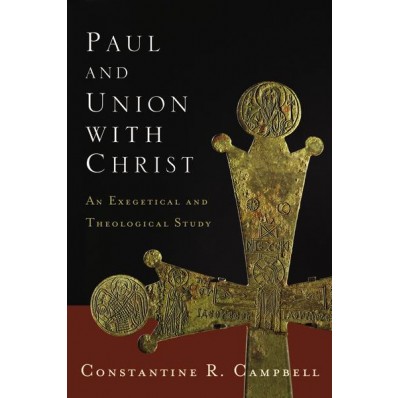Constantine Campbell. Union with Christ: An Exegetical and Theological Study. Zondervan: Grand Rapids, 2012. 463 pgs. (Paperback). $34.99. 0310329051 Campbell seeks to approach the subject “union with Christ” as a New Testament theologian, that is, his approach is exegetically grounded and theologically motivated. The first concern is represented by detailed exegetical work on the phrases relating to “union with Christ.” The theological concern is woven into this, but is then fully fleshed out in the final section of the book. From the outset, Campbell informs the reader of three basic conclusions: 1. The term “union with Christ” is “insufficient to convey all that Paul includes in the theme.” In its place, is the “metatheme” of union, participation, identification, incorporation” which includes many characteristics (pg. 29). 2. This metatheme is found in “Jewish theology” but especially in Jesus’ words to Paul on the Damascus road. 3. The metatheme is “of the utmost importance to Paul, yet does not occupy the ‘centre’ of his theological framework” (pg. 30).
Campbell begins by highlighting landmark scholarly studies through the 20th century. This allows Campbell to simultaneously establish the context of his own work while introducing the multifaceted problems associated with defining and conceptualizing Paul’s thought before turning to the exegetical portion of the study. Over 250 pages are then devoted to an examination of the phrases relating to Paul’s “metatheme” beginning with the relevant prepositional phrases, ἐν Χριστῷ, εἰς Χριστὸν, σὺν Χριστῷ, and διὰ Χριστοῦ, and concluding with a chapter on relevant Pauline metaphors. From the outset Cambell informs the reader that prepositions are notoriously indefinite, for instance he lists twelve possible meanings for ἐν, and ten for εἰς, the tenth being “other uses” (pg. 201). While these prepositional phrases are crucial, they must be dealt with as multivalent idioms rather than technical terms. For example, on “ἐν Χριστῷ”, Campbell writes,
These idioms can express instrumentality, close association, agency, recognition, cause, king and manner, locality, specification or substance, circumstance or condition, the object of faith, incorporation, union, reference or respect, and participation. It is, therefore impossible to define the meaning of these idioms by a single description as if they were formulaic. (pg. 199)
The other prepositions (σὺν and διὰ) are more straightforward, but are used less often than ἐν or εἰς. This does not diminish their importance, but does give us a smaller sample. Σὺν and σὺν-compounds convey participation with Christ, “believers partake with Christ in his death, burial, resurrection, ascension, glorification, and session in heaven.” (pg. 236) Διὰis, “best described as mediatorial: ‘Christ mediates the action of another.” (pg. 266) There is significant overlap between each of these prepositions, however, especially in comparison to ἐνand εἰς. Equally illuminating are Paul’s frequent metaphors that have bearing on the metatheme of “union with Christ.” Campbell discusses the metaphors related to body, temple, building, marriage, and clothing. Metaphor is one of Paul’s “most potent tools” for describing union with Christ. (pg. 323)
The final section of the book is devoted to a theological study based on the exegetical results. It is in this section that Campbell most fully develops his own position on the subject, elaborating on how the exegetical work has bearing on Paul’s understanding of the work of Christ, his “implicit Trinitarianism” (pg. 353), Christian living, and justification. From this Campbell substantiates his threefold “definition” of union with Christ. Though he describes union with Christ with nine terms (location, identification, participation, incorporation, instrumentality, Trinity, union, eschatology, spiritual reality) only four of these are built into his definition: union, participation, identification, and incorporation. This heavily favours a “mystical” reading of the theme, though that specific term is rejected as “unhelpfully vague”. (pg. 412) Campbell concludes that “original catalyst” and clearest antecedent for Paul’s theology was the Damascus Road experience. But, curiously, this only receives about a paragraph of discussion while discussion of parallels with John’s gospel receives a much fuller treatment. Campbell’s final point concerns how “union with Christ” is to be conceptualized: is it the “centre” or “key” of Paul’s thought, or is some other metaphor more appropriate. Campbell concludes that the image of a web is more appropriate than either, and that “union with Christ” is the webbing that holds together all of Paul’s thought.
Campbell’s study is highly useful and is to be commended on several points. First, his exegetical work will no doubt prove controversial in some instances, but it is a valuable point of reference for anyone working on the subject. Second, his focus on the ultimate theological implications is most welcome, and will surely be warmly received in those circles concerned with New Testament theology. Third, Campbell helpfully includes multiple voices in the conversation and introduces the reader to many differing positions before he puts forward his own conclusions. Finally, Campbell’s scope is wide enough to include many points of relevant data that may have been otherwise overlooked. The final strength may also be a weakness of Campbell’s study, however. In the concluding sections the reader may find themselves wondering if “union with Christ” has been so broadly defined that its usefulness as a specific concept is somewhat lost. This is exacerbated if the web metaphor is taken in full force. If Paul’s thought is a web, and “union with Christ” is the webbing, then it would seem that everything in Paul’s theology is caught up or connected by this theme. This might very well be the case, but it makes it quite difficult to isolate the distinctives of the “metatheme” itself. Nevertheless, Campbell work is an invaluable resource as an exegetical reference and a source of theological reflection and synthesis. For the serious scholar or the interested layman Paul and Union with Christ is both a helpful starting point as well as a highly insightful exploration of a massive theological and exegetical topic.
The Bottom Line: Working as a biblical theologian Campbell addresses Paul’s use of the theme “union with Christ” from both exegetical and theological angles. He concludes that “union with Christ” is the metatheme that forms the webbing that ties together the web of Paul’s theology.





Leave a Reply
Your email is safe with us.